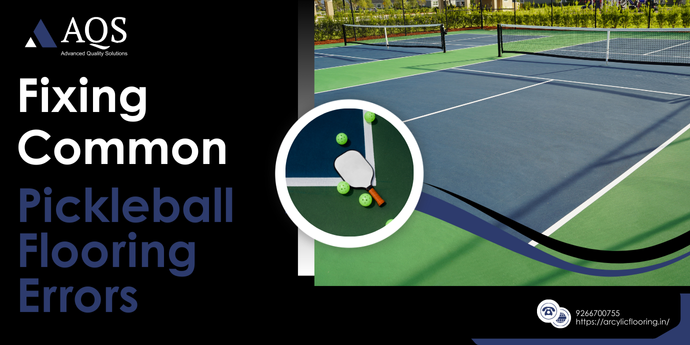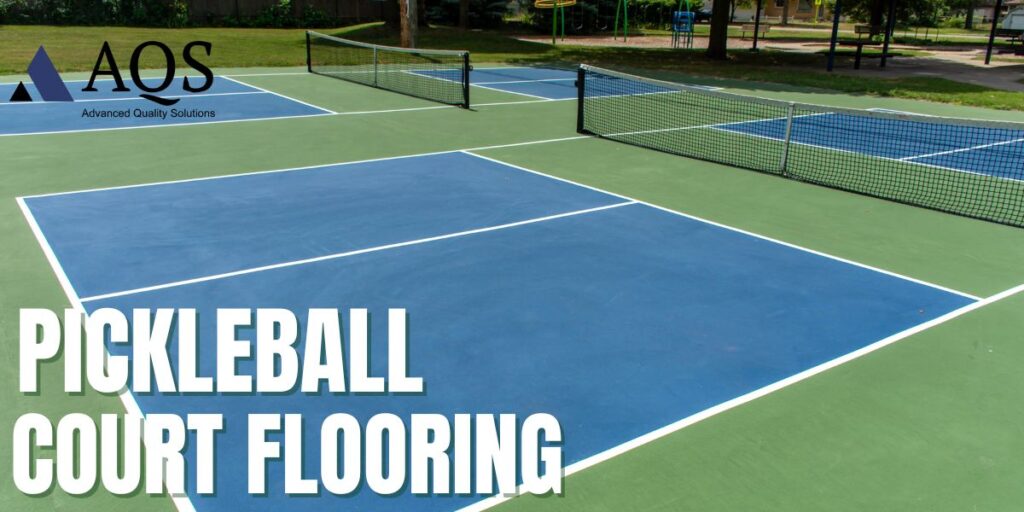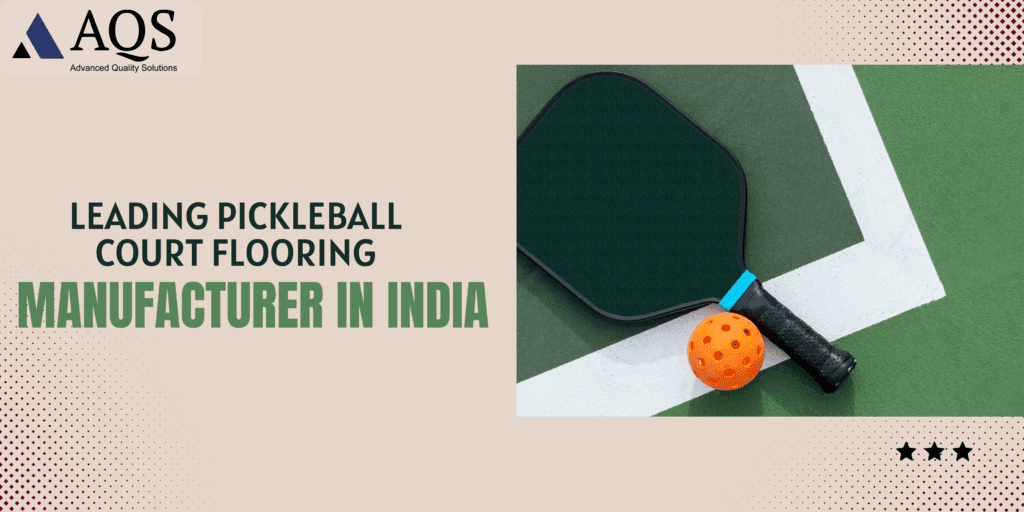
Pickleball has shifted from a casual backyard game to one of the fastest-growing sports around the world. India is jumping on this trend too. People want pickleball courts everywhere, from high-end housing complexes to company recreation zones and sports clubs. Even though excitement for the sport keeps climbing, the quality of court construction often creates mistakes in pickleball court flooring . A good pickleball court takes more than just some paint slapped on concrete. The pickleball court flooring material you decide on, how you prepare the base, the direction the court faces, and how you handle water drainage all affect how well the court performs, how safe it is, and how long it lasts.
At AQS, we’ve worked on projects where pickleball courts started showing big problems as early as two years after being installed. Courts had uneven surfaces, colors that faded fast, slippery spots, or even puddles forming after a little rain. What makes it worse? All of these issues could’ve been avoided with better planning, proper pickleball court materials, and quality work. This guide will walk you through the most common mistakes made in pickleball court flooring based on years of real-world experience. We’ll also explain how to fix or prevent these problems. Whether you’re building a new court or improving an old one, knowing these pickleball court flooring mistakes can save you money and keep your court in great shape for years to come.
Why Mistakes in Pickleball Court Flooring Can Be Expensive
Mistakes during pickleball court construction can lead to big costs. Fixing serious problems after your pickleball floor has been put in often requires resurfacing or even tearing out large parts of the court.
Here’s how poor pickleball flooring and construction end up costing more:
- Wear and tear too soon: Using the wrong pickleball flooring materials or applying them can cause the floor to crack, fade, or peel way before it should.
- Injury risks: Uneven or smooth pickleball court surfaces make it easier for players to slip and get hurt.
- Water troubles: If water doesn’t drain right or if the location is chosen, it can seep in and weaken both the surface and its foundation.
- Playing problems: Uneven ball bounce or slippery spots make games less enjoyable.
Preventing issues costs less than fixing them. Knowing the common errors in pickleball court construction can help you safeguard your project and build a court that fits official pickleball court dimensions while still being great for gameplay.
1. Bad Court Design and Poor Planning
The priciest errors often happen long before you even put down the first layer of pickleball court flooring. Designing a court isn’t as simple as drawing some lines. It includes choosing the right site, setting it up in the right direction, and making sure it meets the official pickleball court size rules.
Where mistakes begin:
- Some sports court builders focus on the 20×44 ft play area and forget to include room for the safety spaces around it.
- Pickleball court builders often ignore how the sun moves, which causes glare during early morning or late-day matches.
- Planning skips wind concerns, and that hurts how well players can perform.
- Pickleball courts sometimes end up in areas prone to flooding because of poor location planning.
Why it matters: Not enough space around courts raises the chance of injuries. Bad orientation makes it harder for players to see and stay comfortable. Poor placement leads to drainage issues from the very start.
Solution:
- Use a complete layout of pickleball court dimensions with a minimum of 10 feet on the sides and 22 feet behind the baselines to allow room.
- Place courts facing north to south to cut down sun glare.
- Study the site’s feasibility before starting. Test the soil, check drainage capabilities, and map the elevation.
- Pick a location that’s easy to access and has good drainage. Ensure the subgrade is stable.
When a pickleball floor begins with solid planning, everything else tends to go. Skipping this step can leave you with a court full of flaws right from the start.
2. Handled Pickleball Court Base Preparation
No matter how nice the pickleball surface looks, it won’t last if the base isn’t strong. Many courts fail because of neglect during sub-base preparation before installing the pickleball court surface.
Mistakes:
- Failing to dig out topsoil, roots, or organic material.
- Placing loose fill or sand without proper packing into place.
- Skipping a moisture barrier in spots where groundwater levels are high.
What happens: The pickleball court settles and causes bumpy play surfaces, cracks, and dips that collect water. Even top-tier pickleball court materials cannot create an unsteady foundation.
Solution:
- Dig out all organic material to a depth of 6–12 inches.
- Use crushed stone or engineered fill instead, and pack it to meet at least 95% Proctor density.
- Add moisture barriers when necessary to stop water from seeping upwards.
- Make sure the base slopes at about a 1% gradient to help with drainage.
Think of the base like the foundation of a house. If it’s done, anything built on top of it will not last as long.
3. Using the Wrong Pickleball Flooring Materials or Surface Texture
Pickleball courts have specific needs that not all sports surfaces meet. Picking the wrong pickleball court floor material or not applying the right one can mess up gameplay and create safety risks.
Common Issues:
- Using coatings made for tennis or basketball court flooring without tweaking them to fit how pickleball requires bounce and grip.
- Adding a surface that’s too smooth, which can cause slipping and falling, if the weather is damp or rainy.
- Using cheap sports flooring materials that crack, fade, or wear down fast in India’s strong UV sunlight.
What happens:
- Players lose confidence because their grip feels poor.
- Balls bounce unpredictably.
- Pickleball court resurfacing expenses pile up after a few years.
Solution:
- Choose acrylic sports coatings made just for pickleball courts.
- Add silica sand in the top layers to get the right texture—good grip for safety but still smooth enough to keep ball movement reliable.
- Use UV-stable pickleball court color pigments to handle intense sunlight.
- Avoid using low-cost sports surface materials that seem affordable at first but end up costing double in maintenance later.
AQS designs its pickleball flooring to provide a mix of strength, grip, and ball performance. These features make it perfect to handle outdoor conditions in India.

4. Skipping Drainage and Weather-proofing in Pickleball Flooring
Water becomes the biggest problem in outdoor sports courts. Even a well-built pickleball court floor would not last long without good drainage systems.
Common mistakes by Pickleball Court builders:
- Building pickleball courts level with no slope to let water flow away.
- Forgetting to add drainage systems around the edges to manage heavy monsoon rains.
- Not sealing edges, allowing water to seep under the layers.
What happens:
- Puddles form, causing bad drainage and the pickleball court surface to weaken.
- Water seeping leads to peeling, cracking, and materials wearing out faster.
- Courts become slippery and risky to use after rain.
How to Avoid This:
- Ensure a slope of 1 inch for every 10 feet to let water drain properly.
- Add trench or French drains around the court edges.
- Apply waterproof sealers and primers during the setup process.
- Plan regular upkeep to remove clogs and check for water issues.
In India’s weather, in coastal areas or during heavy monsoons drainage systems are not an extra feature but a necessity to protect your pickleball court flooring material.
5. Skipping Curing Time or Rushing the Process
Sports floors need proper time to settle, bond, and dry. Rushing the process often causes problems because pickleball flooring builders push to finish and let people use the court too.
Big mistakes during this phase:
- Put on pickleball surface layers before the base has dried.
- Skipping the necessary waiting time between acrylic layers.
- Letting people play on the court before the materials reach full strength.
What impatience costs:
- Layers can come apart, which causes peeling.
- Cracks can show up earlier than they should.
- The pickleball court will wear out faster overall.
Solution:
- Wait at least 28 days to let the concrete base cure before starting any surface work.
- Stick to the sports flooring manufacturer’s instructions to dry layers. Even if it takes an extra day, it’s worth the wait.
- Help facility owners understand why this step matters to make the court last longer.
A built pickleball court adds value for years. Cutting corners creates nothing but future problems.
Conclusion
Building a pickleball court isn’t just about hitting the right pickleball court dimensions. It’s about aiming for strength, safety, and good performance. The five key factors we’ve discussed — design, preparing the base, choosing material, setting up drainage, and letting it cure lay the groundwork for a solid result.
At AQS, we use high-quality pickleball court flooring paired with years of experience to build courts that handle both tough games and India’s changing weather. Whether it’s a home court or a pro tournament setup, our systems focus on durability, player safety, and reliable performance.
Want to create or improve your pickleball court? Reach out to AQS now to get expert advice, top-notch materials, and seamless installation.
Frequently Asked Questions
The standard pickleball court measurement is 20 x 44 feet for both singles and doubles, with additional surrounding space for movement.
Acrylic-coated concrete surfaces provide the best balance of performance, durability, and maintenance ease.
Pickleball court should be resurfaced every 4–6 years, depending on use and climate.
Yes, with proper resurfacing, line markings, and sometimes resizing.




